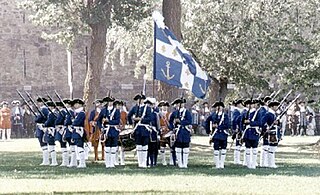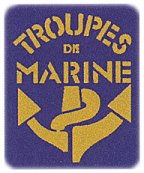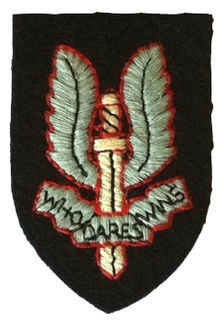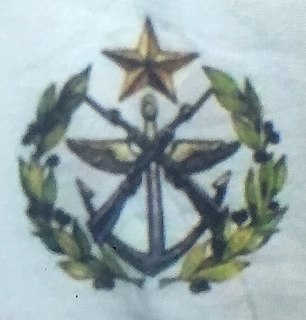
The French Navy, informally "La Royale", is the maritime arm of the French Armed Forces. Dating back to 1624, the French Navy is one of the world's oldest naval forces. It has participated in conflicts around the globe and played a key part in establishing the French colonial empire.

The Commandos Marine are the Special Operation Forces (SOF) of the French Navy. The Commandos Marine are nicknamed Bérets Verts. They operate under the Naval Riflemen and Special Operations Forces Command (FORFUSCO) and form part of the French Special Operations Command.

The Troupes de la Marine, was a military body founded by Cardinal Richelieu in 1622 under the denomination of Compagnies Ordinaires de la Mer, were originally intended to form the garrisons of the ships of the King. It was in 1674 that Jean-Baptiste Colbert decides to make permanent colonial troops and give them the name of Compagnies Franches de la Marine.
French Marines may refer to any of the following:

The Troupes de marine is a subdivision of the French Army that includes several specialities: infantry, artillery, armoured, airborne, engineering and transmissions (Signals). Despite its name, it forms part of the Army, not the Navy. The TDM has gradually become professionalized since 1970.

Rank insignia in the French Army are worn on the sleeve or on shoulder marks of uniforms, and range up to the highest rank of Marshal of France, a state honour denoted with a seven-star insignia that was last conferred posthumously on Marie Pierre Koenig in 1984.

Marines, also known as naval infantry, are typically an infantry force that specializes in the support of naval and army operations at sea and on land, as well as the execution of their own operations. In most countries, the marines are an integral part of that state's navy. In others, it is an independent military branch altogether, such as in the United States, with the Marine Corps. Marines can also fall under a country's army like the Troupes de marine.

The 2nd Foreign Parachute Regiment is the only airborne regiment of the French Foreign Legion. Since the regiment's arrival from Algeria in 1967, it has been stationed at Camp Raffalli near the town of Calvi on the island of Corsica, south of mainland France. It is one of the four infantry regiments of the 11th Parachute Brigade and part of the spearhead of the French rapid reaction force. The regiment is also equipped with Véhicule de l'Avant Blindé (VAB).

The 1st Marine Infantry Parachute Regiment is one of three regiments in the French Army Special Forces Command.

The 1st Free French Division was one of the principal units of the Free French Forces (FFL) during World War II, renowned for having fought the Battle of Bir Hakeim.
1er Bataillon de Fusiliers Marins Commandos was a Fusiliers Marins commando unit of the Free French Navy, raised in 1942, which served during the Second World War. Its initial Commandant was then-Lieutenant de Vaisseau (Captain) Philippe Kieffer of the Free French Navy, under whose command they participated in the Normandy landings in 1944.

Berets have been a component of the uniforms of many armed forces throughout the world since the mid-20th century. Military berets are usually pushed to the right to free the shoulder that bears the rifle on most soldiers, but the armies of some countries, mostly within Europe, South America and Asia have influenced the push to the left.

The National Defence Medal is a French military decoration. It was created by Charles Hernu, Minister of Defence and established by decree on April 21, 1982. It rewards particularly honourable service rendered by military personnel for their participation in operational activities. The medal has three levels: Gold, Silver and Bronze.

The 2nd Parachute Chasseur Regiment or 2e RCP, is one of the most decorated French units of the Second World War, the only land unit awarded the red fourragère in that war, including six citations at the orders of the armed forces. The French Navy 1500-ton class submarine Casabianca also accumulated six citations at the orders of the armed forces and therefore its crewmen were entitled to wear the same fourragère.

The 1er Régiment de Fusiliers Marins 1er RFM French was a unit of the Free French Navy during the campaign of Italy, then in the campaign of France.

The Régiment Blindé de Fusiliers-Marins or (RBFM) was an armored naval infantry regiment of the French 2nd Armored Division. The regiment belonged to the units of the French Fusiliers Marins which are units of the French Navy whose ships were either immobilized or destroyed.
The Brigade des Fusiliers Marins was a unit of the French Navy which fought alongside the Belgium Army in 1914-1915 and which held their ground until the last man standing in October 1914 at Dixmude to halt the advance of the German army and protect Dunkirk.

Marine Fusilier Regiments are marine infantry regiments belonging to the Algerian Navy.






























